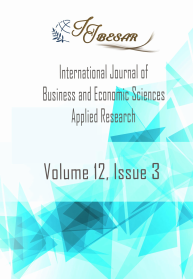The Nexus Between Population and Economic Growth In Ethiopia: An Empirical Inquiry
The Nexus Between Population and Economic Growth In Ethiopia: An Empirical Inquiry
Author(s): Adisu Abebaw DeguSubject(s): Geography, Regional studies, Demography and human biology, Economic development, Post-War period (1950 - 1989), Transformation Period (1990 - 2010), Present Times (2010 - today), Socio-Economic Research
Published by: Τεχνολογικό Εκπαιδευτικό Ίδρυμα Ανατολικής Μακεδονίας και Θράκης
Keywords: Growth Population ARDL; Toda-Yamamoto Causality; Ethiopia;
Summary/Abstract: The link between population growth and economic growth has been becoming of most significant interest for researchers. However, there is no consensus among economists and researchers about the interaction between population and economic growth. Using time series data spanning from the period 1981 to 2018, this study examined the population-economic growth nexus in the second most populous African nation-Ethiopia. The study used yearly time series data spanning from 1981 to 2018, Augmented Dickey Fuller (ADF) and Phillips-Perron (PP) unit root tests, Auto-regressive Distributed Lag (ARDL) co-integration approach and Toda-Yamamoto Causality tests. Population and economic growth (Proxied by GDP) have a long-run association, as confirmed by the bound test co-integration approach. From ARDL model estimates, population growth is found to have a negative and significant effect on economic growth, both in the short-run and in the long-run. Likewise, growth in GDP affects population growth positively and significantly-both in the short-run and long-run. The TodaYamamoto Granger-Causality test revealed that, there is a unidirectional causality running from population to economic growth. The current (as of 2019) number of the total population of Ethiopia exceeds 110 million— making the country the second-most populous nation in Africa. With the prevalence of high fertility rate and mortality rate, unemployment, and poverty, the population is not expected to bring economic development in general and economic growth in particular. Hence, it is advised to the concerned body that anti-natal policies that discourage the fertility rate, need to be re-considered to supplement with economic growth policies. This paper provides an empirical study of population-economic growth nexus in Ethiopia- a low-income country with a rapidly growing economy but also a rapidly increasing population and labor force. An understanding of such an issue would provide a reliable input for formulating development policies. However, up to the best of my knowledge, there is limited empirical research about population-growth nexus growth for the case of Ethiopia.
Journal: International Journal of Business and Economic Sciences Applied Research (IJBESAR)
- Issue Year: 12/2019
- Issue No: 3
- Page Range: 43-50
- Page Count: 8
- Language: English

